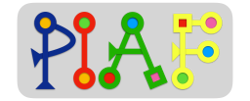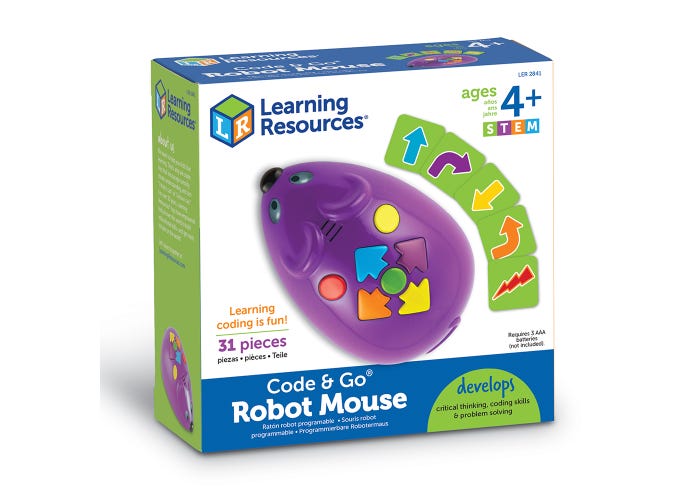Code & Go Robot Mouse
https://www.learningresources.com/stem-robot-mouse
Short description
The “Code & Go Robot Mouse” is a little robot that looks like a mouse with different buttons on its back. These buttons can be used to programme actions that the mouse will execute.
Jack, the fully programmable robot mouse, is ready to follow commands to teach hands-on coding concepts! Create a step-by-step path for Jack using the 30 double-sided coding cards to provide the perfect introduction to coding concepts. Jack lights up, makes sounds, and features 2 speeds and colorful buttons to match coding cards for easy programming and sequencing. Set includes Activity Guide. Jack can also be used with the STEM Robot Mouse Coding Activity Set (LER 2831) for more play options, learning opportunities, and fun!
Material and technical aspects
The robot mouse measures 10 cm in length. It requires 3 AAA batteries to function. Costs about 30€ to buy. There are 30 paper cards with symbols for different actions on them. The basic kit can be extended with an Activity Set that contains plastic tiles with which paths can be set up.
Content
According to the inventors of the “Code & Go Robot Mouse”, it can be used to learn about problem solving, self-correcting errors, critical thinking, analytical thinking, if-then logic, working collaboratively with others, discussion and communication skills, calculating distance, spatial concepts. The task is to give instructions to a robot to move forward, to move backwards, to turn left, to turn right, to make sounds and to light up, in order to reach a certain goal. It is suitable for children 4+ years. The objectives here are the basics of computer coding and programming. The robot can be used to develop the ability to predict where the robot will land after it was given a certain sequence of actions to perform.
Pedagogical aspects
From a pedagogical point of view, this learning resource uses an age-appropriate little robot to learn about programming a robot to execute certain actions or sequences of actions. Children can learn certain standard sequences by following a set of cards given by the teacher (learning by imitating) or they can learn to solve problems themselves (learning by experimentation), where they create a sequence of instructions, test it out and correct it if necessary until they achieve the target goal. Learning can also imply predicting what will happen and discussing various solutions with peers.
Conclusion
Overall, this programmable robot is a nice tool to teach the basics of programming and robotics to young children in a fun and engaging way without requiring a computer and a screen. A highly recommendable pedagogical resource, especially for teachers in early childhood education! Just be sure to always have enough spare batteries that are charged.

